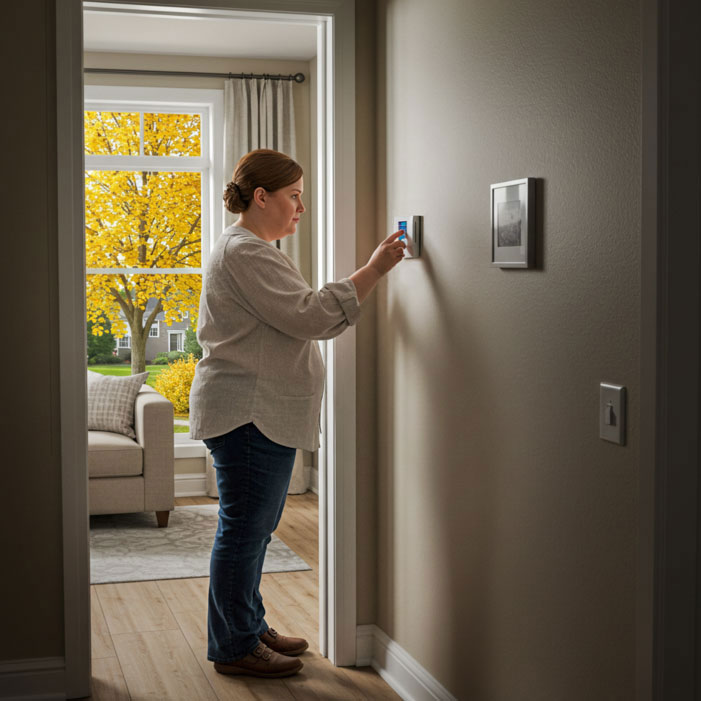
Spring and fall bring mild temperatures and shifting weather patterns. Managing your thermostat during these seasons can help keep your home comfortable without wasting energy. A few adjustments, along with an awareness of outdoor conditions, can make a noticeable difference in comfort and utility costs.
Why Spring and Fall Require a Different Approach
Spring and fall are transitional seasons. Heating and air conditioning systems tend to run less often than in summer or winter, but daily temperature swings can still push indoor comfort out of balance. Mornings might start out chilly, afternoons may warm up quickly, and evenings can cool down fast. These fluctuations mean thermostat settings need to be flexible enough to handle changes without overworking the system.
Recommended Temperature Ranges
Energy experts often suggest daytime thermostat settings around 68–72°F in spring and fall when people are home, and lowering to 60–65°F at night or when away. On warmer fall or spring days, 74–76°F can be reasonable for cooling. But these are guidelines, not fixed rules. Some people might prefer slightly higher or lower temperatures depending on health, comfort preferences, or the layout of their home.
Night settings often differ from day settings because body temperature naturally drops during sleep, making cooler air more comfortable. Small adjustments, such as a two-degree shift, can have a noticeable effect on both comfort and energy use.
Balancing Comfort with Energy Savings
Keeping a consistent temperature range helps avoid sudden spikes in heating or cooling demand. Small changes in settings can lower energy bills without making rooms feel uncomfortable. It's best to adjust gradually rather than making large swings in temperature, which can cause the system to work harder than necessary.
In homes with programmable thermostats, seasonal schedules can be set to match the typical outdoor temperatures for spring and fall. Even without automation, manually shifting the settings once or twice a day can still help maintain balance.
Humidity and Indoor Temperatures
On the East Coast, spring and fall generally don't have the extremes of humidity seen in summer or winter. Winter often feels drier indoors, and summer often feels more humid. In the milder months, indoor humidity usually stays closer to an ideal middle range, which can make rooms feel more comfortable at slightly higher or lower temperatures.
Moderate humidity also means the air feels less stifling when it's warm and less biting when it's cool. Still, during heavy rains in spring or during damp fall days, humidity can increase indoors, so running a fan or briefly using the air conditioning can help keep it comfortable.
Smart Thermostat Features Worth Using
Many modern thermostats include features that can help during transitional seasons. Seasonal scheduling lets you set different temperature targets for different times of day, which can match natural outdoor swings. Remote adjustments through a smartphone app can be useful for unexpected weather changes. Some models also track system run times, which can provide insights into how often heating or air conditioning is used during these milder months. That data can help fine-tune settings for better comfort and efficiency.
Zoning and Room-by-Room Control
Homes with zoning systems can benefit from adjusting each area separately. Rooms that face the sun in the afternoon may heat up faster and need less heating during the day. Shadier rooms might stay cooler and need a slight boost in warmth in the morning or evening.
If zoning isn't available, closing vents in unused rooms or keeping doors shut can help keep temperatures stable where it matters most. This prevents over-conditioning areas that don't need it, which saves energy without impacting comfort in frequently used rooms.
Dealing with Rapid Weather Swings
Spring and fall on the East Coast often bring quick shifts between warm and cool conditions. This makes it important to check both morning and evening forecasts. On cool mornings that lead into warm afternoons, starting the day with the thermostat set for heating and switching to a neutral or cooling mode by midday can keep the indoor temperature from drifting too far in either direction. The reverse applies when a warm morning leads into a sudden evening chill.
Energy-Saving Habits Beyond the Thermostat
A few habits can help make thermostat adjustments more effective in spring and fall.
- Open windows strategically: Let in fresh air when outdoor temperatures are close to your comfort range.
- Use ceiling fans: Set them to spin counterclockwise in warmer weather to push cool air down, or clockwise on low in cooler weather to circulate warm air.
- Block heat loss or gain: Close blinds or curtains on hot afternoons to keep out solar heat, or open them on cool days to let sunlight warm the room.
These small steps reduce how often the heating or air conditioning system needs to run, lowering energy use without sacrificing comfort.
Seasonal Maintenance Checks
Spring and fall are ideal times to do air conditioning maintenance and heating maintenance before the heavier use of summer or winter. Changing filters can improve airflow and efficiency. Checking thermostat calibration ensures the displayed temperature matches the actual indoor temperature. This is also a good time to listen for unusual noises, make sure vents are clear of obstructions, and test both heating and cooling modes to confirm they're ready for the coming season.
Consider investing in a heating and air conditioning service contract, which will usually include seasonal checks automatically.
Balancing comfort and efficiency in spring and fall comes down to paying attention to outdoor conditions, adjusting settings in small increments, and taking advantage of mild weather when possible. These transitional months offer a chance to keep energy bills down while still enjoying a comfortable indoor climate.
By setting thoughtful temperature targets, making occasional manual changes, and combining thermostat use with small daily habits, households can move smoothly through the shifting weather patterns of these milder seasons.
See more tips on how to deal with fall temperature fluctuations when it comes to heating and air conditioning.


